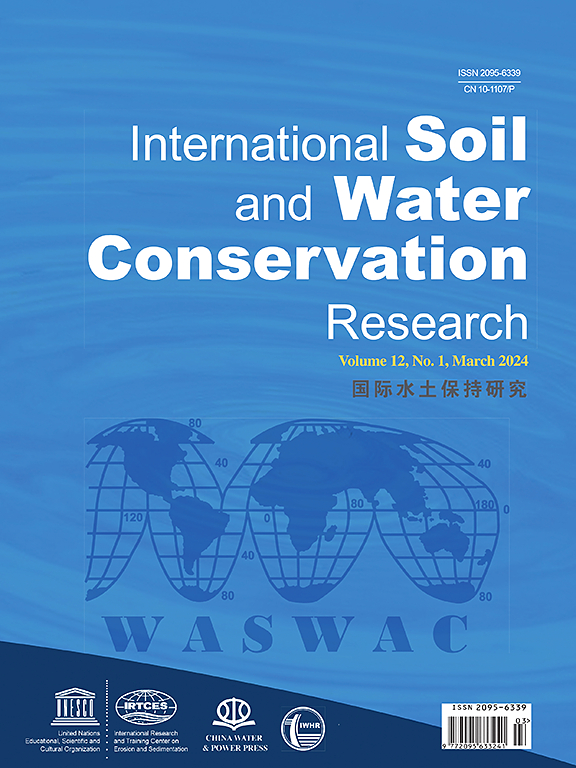Digital mapping of soil inorganic carbon content and density in soil profiles after ‘Grain for Green’ program
IF 7.3
1区 农林科学
Q1 ENVIRONMENTAL SCIENCES
International Soil and Water Conservation Research
Pub Date : 2025-04-08
DOI:10.1016/j.iswcr.2025.03.007
引用次数: 0
Abstract
Soil inorganic carbon (SIC) is vital for terrestrial carbon reservoirs and the global carbon cycle. Understanding its spatial distribution is essential for environmental management and climate change mitigation. However, there remains a significant gap in predicting the spatial distribution of SIC content (SICC) and density (SICD), and our comprehension of the combined influences of natural factors and human activities on SIC is limited. This study in the Loess Plateau aimed to predict the spatial distribution of SIC content and density using data from 142 soil profiles and environmental covariates. We evaluated random forest (RF), support vector machine (SVM), and Cubist models for their predictive performance using metrics like coefficient of determination (R2), root mean square error (RMSE), and mean absolute error (MAE). Landscape analysis revealed that land use significantly impacts both horizontal and vertical distributions of SICC and SICD, with leaching being a critical factor. Terrain attributes influenced these patterns by affecting sunlight exposure and hydrothermal conditions. Remote sensing technologies proved valuable for predictions. RF outperformed SVM and Cubist, yielding robust results for SICC (R2: 0.317–0.514, RMSE: 1.386–4.194 g/kg, and MAE: 1.045–2.940 g/kg) and SICD (R2: 0.282–0.490, RMSE: 0.220–1.069 kg m−2, and MAE: 0.174–0.772 kg m−2). RF was used to estimate total SIC stocks at 286.92 × 106 kg, with 49 % found in the 100–200 cm layer, underscoring the carbon sequestration potential of deeper soils. These insights are crucial for policymakers to understand SIC variability and inform sustainable land management strategies.

“退耕还林”项目后土壤剖面中土壤无机碳含量和密度的数字制图
土壤无机碳(SIC)对陆地碳库和全球碳循环至关重要。了解其空间分布对环境管理和减缓气候变化至关重要。然而,在预测碳化硅含量(SICC)和密度(SICD)的空间分布方面仍存在较大差距,对自然因素和人类活动对碳化硅的综合影响认识有限。利用142个土壤剖面和环境协变量数据,对黄土高原土壤中碳化硅含量和密度的空间分布进行了预测。我们使用决定系数(R2)、均方根误差(RMSE)和平均绝对误差(MAE)等指标来评估随机森林(RF)、支持向量机(SVM)和立体主义模型的预测性能。景观分析结果表明,土地利用对土壤碳含量和土壤碳含量的水平和垂直分布均有显著影响,淋滤是影响土壤碳含量和土壤碳含量的关键因素。地形属性通过影响阳光照射和热液条件来影响这些模式。遥感技术证明对预测很有价值。RF优于SVM和Cubist,在SICC (R2: 0.317-0.514, RMSE: 1.384 - 4.194 g/kg, MAE: 1.045-2.940 g/kg)和SICD (R2: 0.282-0.490, RMSE: 0.220-1.069 kg m - 2, MAE: 0.174-0.772 kg m - 2)上产生了稳健的结果。利用RF估计,总碳化硅储量为286.92 × 106 kg,其中49%分布在100-200 cm土层,表明深层土壤具有固碳潜力。这些见解对于决策者理解SIC变异性并为可持续土地管理战略提供信息至关重要。
本文章由计算机程序翻译,如有差异,请以英文原文为准。
求助全文
约1分钟内获得全文
求助全文
来源期刊

International Soil and Water Conservation Research
Agricultural and Biological Sciences-Agronomy and Crop Science
CiteScore
12.00
自引率
3.10%
发文量
171
审稿时长
49 days
期刊介绍:
The International Soil and Water Conservation Research (ISWCR), the official journal of World Association of Soil and Water Conservation (WASWAC) http://www.waswac.org, is a multidisciplinary journal of soil and water conservation research, practice, policy, and perspectives. It aims to disseminate new knowledge and promote the practice of soil and water conservation.
The scope of International Soil and Water Conservation Research includes research, strategies, and technologies for prediction, prevention, and protection of soil and water resources. It deals with identification, characterization, and modeling; dynamic monitoring and evaluation; assessment and management of conservation practice and creation and implementation of quality standards.
Examples of appropriate topical areas include (but are not limited to):
• Conservation models, tools, and technologies
• Conservation agricultural
• Soil health resources, indicators, assessment, and management
• Land degradation
• Sustainable development
• Soil erosion and its control
• Soil erosion processes
• Water resources assessment and management
• Watershed management
• Soil erosion models
• Literature review on topics related soil and water conservation research
 求助内容:
求助内容: 应助结果提醒方式:
应助结果提醒方式:


